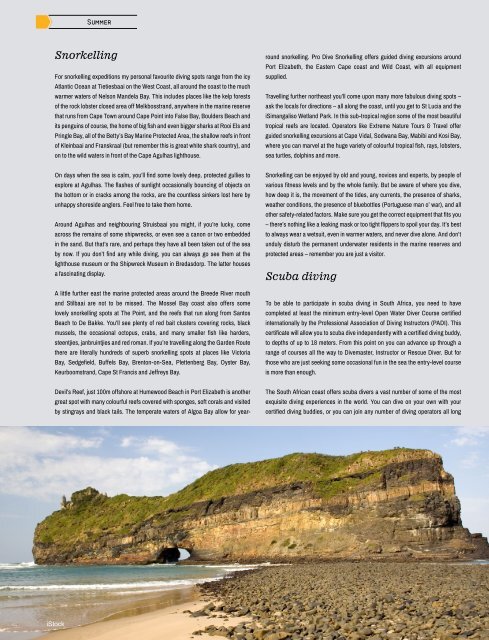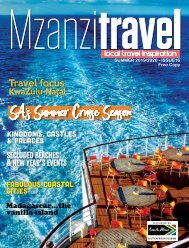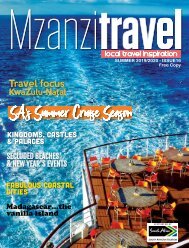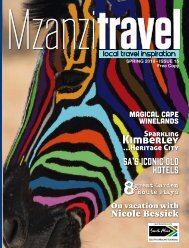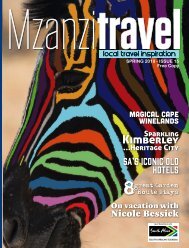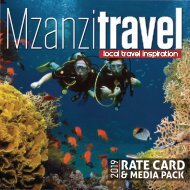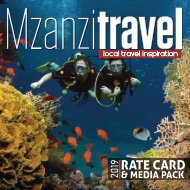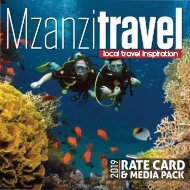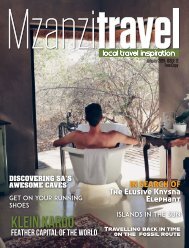Create successful ePaper yourself
Turn your PDF publications into a flip-book with our unique Google optimized e-Paper software.
Summer<br />
Snorkelling<br />
For snorkelling expeditions my personal favourite diving spots range from the icy<br />
Atlantic Ocean at Tietiesbaai on the West Coast, all around the coast to the much<br />
warmer waters of Nelson Mandela Bay. This includes places like the kelp forests<br />
of the rock lobster closed area off Melkbosstrand, anywhere in the marine reserve<br />
that runs from Cape Town around Cape Point into False Bay, Boulders Beach and<br />
its penguins of course, the home of big fish and even bigger sharks at Rooi Els and<br />
Pringle Bay, all of the Betty’s Bay Marine Protected Area, the shallow reefs in front<br />
of Kleinbaai and Franskraal (but remember this is great white shark country), and<br />
on to the wild waters in front of the Cape Agulhas lighthouse.<br />
by stingrays and black tails. The temperate waters of Algoa Bay allow for yearround<br />
snorkelling. Pro Dive Snorkelling offers guided diving excursions around<br />
Port Elizabeth, the Eastern Cape coast and Wild Coast, with all equipment<br />
supplied.<br />
<strong>Travel</strong>ling further northeast you’ll come upon many more fabulous diving spots –<br />
ask the locals for directions – all along the coast, until you get to St Lucia and the<br />
iSimangaliso Wetland Park. In this sub-tropical region some of the most beautiful<br />
tropical reefs are located. Operators like Extreme Nature Tours & <strong>Travel</strong> offer<br />
guided snorkelling excursions at Cape Vidal, Sodwana Bay, Mabibi and Kosi Bay,<br />
where you can marvel at the huge variety of colourful tropical fish, rays, lobsters,<br />
sea turtles, dolphins and more.<br />
On days when the sea is calm, you’ll find some lovely deep, protected gullies to<br />
explore at Agulhas. The flashes of sunlight occasionally bouncing of objects on<br />
the bottom or in cracks among the rocks, are the countless sinkers lost here by<br />
unhappy shoreside anglers. Feel free to take them home.<br />
Around Agulhas and neighbouring Struisbaai you might, if you’re lucky, come<br />
across the remains of some shipwrecks, or even see a canon or two embedded<br />
in the sand. But that’s rare, and perhaps they have all been taken out of the sea<br />
by now. If you don’t find any while diving, you can always go see them at the<br />
lighthouse museum or the Shipwreck Museum in Bredasdorp. The latter houses<br />
a fascinating display.<br />
A little further east the marine protected areas around the Breede River mouth<br />
and Stilbaai are not to be missed. The Mossel Bay coast also offers some<br />
lovely snorkelling spots at The Point, and the reefs that run along from Santos<br />
Beach to De Bakke. You’ll see plenty of red bait clusters covering rocks, black<br />
mussels, the occasional octopus, crabs, and many smaller fish like harders,<br />
steentjies, janbruintjies and red roman. If you’re travelling along the Garden Route<br />
there are literally hundreds of superb snorkelling spots at places like Victoria<br />
Bay, Sedgefield, Buffels Bay, Brenton-on-Sea, Plettenberg Bay, Oyster Bay,<br />
Keurboomstrand, Cape St Francis and Jeffreys Bay.<br />
Snorkelling can be enjoyed by old and young, novices and experts, by people of<br />
various fitness levels and by the whole family. But be aware of where you dive,<br />
how deep it is, the movement of the tides, any currents, the presence of sharks,<br />
weather conditions, the presence of bluebottles (Portuguese man o’ war), and all<br />
other safety-related factors. Make sure you get the correct equipment that fits you<br />
– there’s nothing like a leaking mask or too tight flippers to spoil your day. It’s best<br />
to always wear a wetsuit, even in warmer waters, and never dive alone. And don’t<br />
unduly disturb the permanent underwater residents in the marine reserves and<br />
protected areas – remember you are just a visitor.<br />
Scuba diving<br />
To be able to participate in scuba diving in South Africa, you need to have<br />
completed at least the minimum entry-level Open Water Diver Course certified<br />
internationally by the Professional Association of Diving Instructors (PADI). This<br />
certificate will allow you to scuba dive independently with a certified diving buddy,<br />
to depths of up to 18 meters. From this point on you can advance up through a<br />
range of courses all the way to Divemaster, Instructor or Rescue Diver. But for<br />
those who are just seeking some occasional fun in the sea the entry-level course<br />
is more than enough.<br />
Devil’s Reef, just 100m offshore at Humewood Beach in Port Elizabeth is another<br />
great spot with many colourful reefs covered with sponges, soft corals and visited<br />
The South African coast offers scuba divers a vast number of some of the most<br />
exquisite diving experiences in the world. You can dive on your own with your<br />
certified diving buddies, or you can join any number of diving operators all long<br />
iStock


